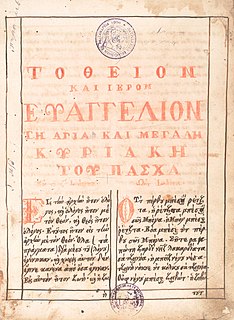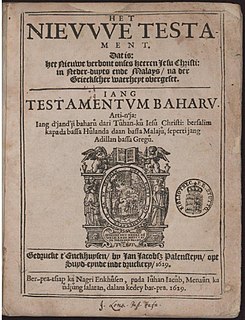
The translation of the Bible into the Manchu language was started in the 18th century, but only the translation of the New Testament has been published.

The translation of the Bible into the Manchu language was started in the 18th century, but only the translation of the New Testament has been published.
The Jesuit scholar and painter at the court of the Qianlong Emperor, Louis Antoine de Poirot (1735–1813), made a translation of the Old Testament into Manchu some time before 1790, but this translation was never published. A copy of the translation is preserved in the library of the British and Foreign Bible Society in London. [1]
The first published translation of the Bible into Manchu was made by Stepan Vaciliyevich Lipovtsov [Степан Васильевич Липовцов] (1770–1841). Lipovtsov had been a member of the eighth Russian Ecclesiastical Mission in Beijing from 1794 to 1807, where he had learned Manchu, and was later a member of the Russian Foreign Office. The British and Foreign Bible Society commissioned Lipovtsov to translate the Gospel of Matthew into Manchu.[ citation needed ] In 1822, 550 copies of the translated Gospel of Matthew were printed in Saint Petersburg; however, most of these were destroyed in a flood. [2]
In 1833 the British and Foreign Bible Society sent George Borrow (1803–1881) to Russia to supervise the completion of the translation of the New Testament into Manchu. Borrow learned Manchu in six months using Lipovtsov's translation and a Manchu-French dictionary. Within two years Lipovtsov and Borrow had completed the translation of the New Testament, and in 1835, 1,000 copies were printed in Saint Petersburg. Borrow wanted to go to China to distribute the translation, but the Russian authorities refused to let him take the Bible with him in case it damaged diplomatic relations between Russia and China. It was not until ten years later that the translation made its way to China. In 1859, parallel Chinese and Manchu translations of the Gospels of Matthew and Mark were printed in China, but by then Manchu was no longer a widely spoken language. [2] A reprint of the Manchu translation of the New Testament was made in Shanghai in 1929. [1]
ᠮᡠᠰᡝᡳ
ᡝᠵᡝᠨ
ᡳᠰᡠᠰ
ᡥᡝᡵᡳᠰᡨᠣᠰ
ᡳ
ᡨᡠᡨᠠᠪᡠᡥᠠ
ᡳᠴᡝ
ᡥᡝᠰᡝ Wylie: Mousei echen Isus Gheristos i tutapuha itche ghese, Möllendorff: Musei ejen Isus Heristos i tutabuha ice hese, the New Testament, published under the British and Foreign Bible Society.
The following is a sample showing the Manchu translation of the Lord's Prayer from Gospel of Matthew chapter 6 verses 9–13, together with the corresponding English translation from the Authorized King James Version of 1611.
| Translation | Mathew 6:9–13 | Transliteration |
|---|---|---|
| Authorized Version , 1611 | Our Father which art in heaven, Hallowed be thy name. ¹⁰Thy kingdom come, Thy will be done in earth, as it is in heaven. ¹¹Give us this day our daily bread. ¹²And forgive us our debts, as we forgive our debtors. ¹³And lead us not into temptation, but deliver us from evil: For thine is the kingdom, and the power, and the glory, for ever. Amen. | |
| S. V. Lipovtsov, 1822 | ᠠᠪᡴᠠ ᡩᡝ ᠪᡳᠰᡳᡵᡝ ᠮᡠᠰᡝᡳ ᠠᠮᠠ᠈ ᠠᠮᠠ ᡳ ᠴᠣᠯᠣ ᡤᡳᠩᡤᡠᠯᡝᠮᡝ ᡨᡠᡴᡳᠶᠠᡴᡳᠨᡳ᠈ ᠠᠮᠠ ᡳ ᡤᡠᡵᡠᠨ ᡝᠩᡤᡝᠯᡝᠨᠵᡳᡴᡳᠨᡳ᠈ ᠠᠮᠠ ᡳ ᡥᡝᠰᡝ ᠠᠪᡴᠠ ᡩᡝ ᠶᠠᠪᡠᠪᡠᡵᡝ ᠰᠣᠩᡴᠣᡳ ᠨᠠ ᡩᡝ ᠶᠠᠪᡠᠪᡠᡴᡳᠨᡳ᠉ ᠮᡝᠨᡳ ᡳᠨᡝᠩᡤᡳᡩᠠᡵᡳ ᠪᠠᡳᡨᠠᠯᠠᡵᠠ ᠵᡝᠮᡝᠩᡤᡝ ᠪᡝ ᡝᠨᡝᠩᡤᡳ ᠮᡝᠨᡩᡝ ᡧᠠᠩᠨᠠᡵᠠ᠈ ᠮᡝᠨᡩᡝ ᡝᡩᡝᠯᡝᡥᡝ ᡠᡵᠰᡝ ᠪᡝ ᠮᡝᠨᡳ ᡤᡠᠸᡝᠪᡠᡵᡝ ᠪᠠ ᡨᡠᠸᠠᠮᡝ᠈ ᠮᡝᠨᡳ ᠠᠮᠠ ᡩᡝ ᡝᡩᡝᠯᡝᡥᡝ ᠪᠠᠪᡝᠪ ᡤᡠᠸᡝᠪᡠᡵᡝ᠈ ᠮᡝᠮᠪᡝ ᡝᠨᡩᡝᠪᡠᡵᡝ ᠪᠠᡩᡝ ᡳᠰᡳᠪᡠᡵᠠᡴᡡ᠈ ᡝᠯᡝᠮᠠᠩᡤᠠ ᡝᡥᡝ ᠴᡳ ᡠᡴᠰᠠᠯᠠᡵᠠ ᠪᡝ ᠪᠠᡳᡵᡝᠩᡤᡝ᠈ ᠴᠣᡥᠣᠮᡝ ᡤᡠᡵᡠᠨ ᡨᠣᠣᠰᡝ᠈ ᡨᡝᠨ ᡳ ᡩᡝᡵᡝᠩᡤᡝ ᡝᠨᡨᡝᡥᡝᠮᡝ ᠠᠮᠠ ᡩᡝ ᠪᡳ ᠰᡝᡵᡝ ᡩᡠᡵᡤᡠᠨ᠈ ᠠᠮᡝᠩ᠉ | Abka de bisire musei ama, ama i colo gingguleme tukiyakini, ama i gurun enggelenjikini, ama i hese abka de yabubure songkoi na de yabubukini. Meni inenggidari baitalara jemengge be enenggi mende xangnara, mende edelehe urse be meni guwebure ba tuwame, meni ama de edelehe babe guwebure, membe endebure bade isiburakv, elemangga ehe ci uksalara be bairengge, cohome gurun toose, ten i derengge enteheme ama de bi sere durgun, ameng. |

George Henry Borrow was an English writer of novels and of travel books based on his personal experiences in Europe. During his travels, he developed a close affinity with the Romani people of Europe, who figure prominently in his work. His best-known books are The Bible in Spain, and the novels Lavengro and The Romany Rye recalling his time with the English Romanichal (Gypsies).

The British and Foreign Bible Society, often known in England and Wales as simply the Bible Society, is a non-denominational Christian Bible society with charity status whose purpose is to make the Bible available throughout the world.

Bible translations into Chinese include translations of the whole or parts of the Bible into any of the levels and varieties of the Chinese language. The first translations may have been made as early as the 7th century AD, but the first printed translations appeared only in the nineteenth century. Progress on a modern translation was encumbered by denominational rivalries, theological clashes, linguistic disputes, and practical challenges at least until the publication of the Protestant Chinese Union Version in 1919, which became the basis of standard versions in use today.
The Serampur Mission Press was a book and newspaper publisher that operated in Serampur, Danish India, from 1800 to 1837.

The royal Tetraevangelia of Ivan Alexander is an illuminated manuscript Gospel Book in middle Bulgarian, prepared and illustrated in 1355–1356 for Tsar Ivan Alexander of the Second Bulgarian Empire. The manuscript is regarded as one of the most important manuscripts of medieval Bulgarian culture. The manuscript, now in the British Library, contains the text of the Four Gospels illustrated with 366 miniatures and consists of 286 parchment folios, 33 by 24.3 cm in size.
The earliest preserved translation of the Bible into the Mongolian language dates to 1827, but there is a written record of what may perhaps have been a translation existing as early as 1305. Since 1827, numerous other translations have been made.

The history of Bible translations into Macedonian is connected in its early years with the history of Bible translations into Bulgarian. Prior to the codification of the standard Macedonian during 1945, Macedonian dialects were described by most linguists as being dialects of the Bulgarian language. The label "Bulgarian language" for various Macedonian dialects can be seen from early texts written in the local Slavic vernacular in Macedonia in the 18th and the 19th century and their authors referred to their language as Bulgarian. For Bulgarian researchers these vernacular Slavic translations of the gospel belong to the Bulgarian cultural tradition.
Work on translation of the Bible into the Kazakh language began with the work of Charles Fraser of the Scottish Missionary Society. Fraser's translation of Matthew was published in 1818, and the New Testament in 1820 by the Russian Bible Society. J. M. E. Gottwald, a professor at Kazan University, revised it, and this was published in 1880 by the British and Foreign Bible Society in Kazan, and it was republished in 1887, and 1910. George W. Hunter, of the China Inland Mission in Ürümqi, considered this translation to be "a good translation, into Astrahan-Turki", he does not seem to have considered it to be Kazakh. Darlow and Moule say that it was intended for Kyrgyz in the neighbourhood of Orenburg, and the language was sometimes called "Orenburg Tatar". According to Rev. W. Nicholson of the Royal Asiatic Society in St Petersburg this translation was intended for "The Kirghese hordes—Great, Little, and Middle, as they are called—[who] occupy various regions in Southern Siberia, Central Asia, and west of the Caspian Sea." George A. King says Fraser's translation was into the language of the "Western Kirghiz or Kirghiz-Kazak, though they disown the name Kirghiz".
Bible translations into Oceanic languages have a relatively closely related and recent history.
The first biblical text in Ainu language appeared in 1887, when a tentative edition of 250 copies of Matthew 1-9, translated from the Greek with the aid of the Revised Version, by John Batchelor, assisted by a local Ainu, was published. Matthew and Jonah, by the same translator, were issued in 1889, the proofs being read by Mr. George Braithwaite, the agent of the British and Foreign Bible Society in Japan. In 1891 Mr. Batchelor returned to England and published the remaining Gospels. In 1893 a tentative edition of 300 each of Galatians, Ephesians, and Philippians, by the same translator, was prepared, which was published at Yokohama by a joint committee of the three Bible Societies in 1894. The Psalms and revised Gospels were issued in 1895. In 1897 a revised New Testament, by the same translator, with Ainu aid, was published at Yokohama by the joint committee.
Biblical translations into the indigenous languages of North and South America have been produced since the 16th century.

The Athabaskan language family is divided into the Northern Athabaskan, Pacific Coast Athabaskan and Southern Athabaskan groups. The full Bible has been translated into two Athabaskan languages, and the complete New Testament in five more. Another five have portions of the Bible translated into them. There are no Pacific Coast Athabaskan languages with portions of the Bible translated into them.

Malaysian and Indonesian Bible translations have a lot of common history up until the modern era. Apart from the shared Malay language which historically was the lingua franca of the Malay archipelago and forms the basis for the national languages of Indonesia and Malaysia today, portions of the Bible have been translated into a variety of indigenous languages in the region.
The Bible was translated into the Manx language, a Gaelic language related to Irish and Scots Gaelic, in the 17th and 18th centuries.
The Bible has been translated into many of the languages of China besides Chinese. These include major minority languages with their own literary history, including Korean, Mongolian, Tibetan, Kazakh, Kyrgyz, Russian and Uyghur. The other languages of China are mainly tribal languages, mainly spoken in Yunnan in Southwest China.
Traditionally Russia used the Old Church Slavonic language and Slavonic Bible, and in the modern era Bible translations into Russian. The minority languages of Russia usually have a much more recent history, many of them having been commissioned or updated by the Institute for Bible Translation.

Bible translations into Eskimo-Aleut languages include:
The history of all Bible translations into Slavic languages begins with Bible translations into Church Slavonic. Other languages include: